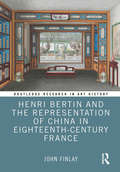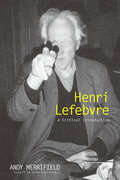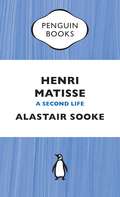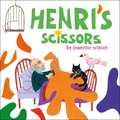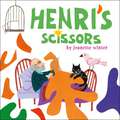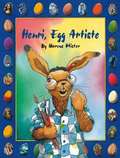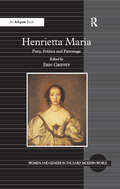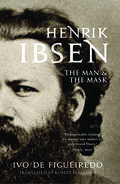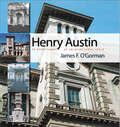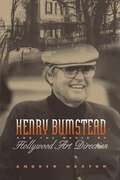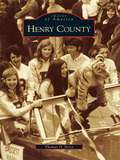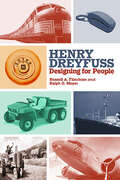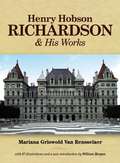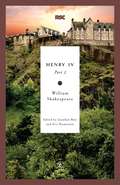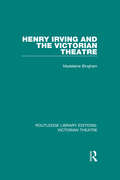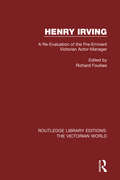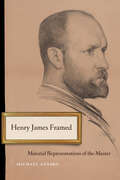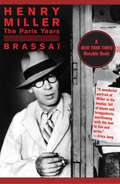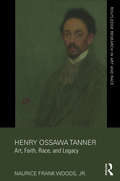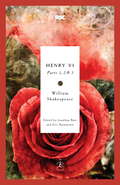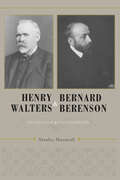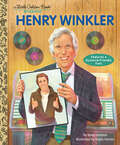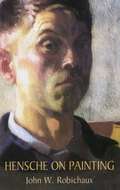- Table View
- List View
Henri Bertin and the Representation of China in Eighteenth-Century France (Routledge Research in Art History)
by John FinlayThis is an in-depth study of the intellectual, technical, and artistic encounters between Europe and China in the late eighteenth century, focusing on the purposeful acquisition of information and images that characterized a direct engagement with the idea of "China." The central figure in this story is Henri-Léonard Bertin (1720–1792), who served as a minister of state under Louis XV and, briefly, Louis XVI. Both his official position and personal passion for all things Chinese placed him at the center of intersecting networks of like-minded individuals who shared his ideal vision of China as a nation from which France had much to learn. John Finlay examines a fascinating episode in the rich history of cross-cultural exchange between China and Europe in the early modern period, and this book will be an important and timely contribution to a very current discussion about Sino-French cultural relations. This book will be of interest to scholars in art history, visual culture, European and Chinese history.
Henri Lefebvre on Space: Architecture, Urban Research, and the Production of Theory
by Łukasz StanekIn this innovative work, Lukasz Stanek frames a uniquely contextual appreciation of Henri Lefebvre&’s idea that space is a social product. Stanek explicitly confronts both the philosophical and the empirical foundations of Lefebvre&’s oeuvre, especially his direct involvement in the fields of urban development, planning, and architecture. Countering the prevailing view, which reduces Lefebvre&’s theory of space to a projection of his philosophical positions, Stanek argues that Lefebvre&’s work grew out of his concrete, empirical engagement with everyday practices of dwelling in postwar France and his exchanges with architects and planners. Stanek focuses on the interaction between architecture, urbanism, sociology, and philosophy that occurred in France in the 1960s and 1970s, which was marked by a shift in the processes of urbanization at all scales, from the neighborhood to the global level. Lefebvre&’s thinking was central to this encounter, which informed both his theory of space and the concept of urbanization becoming global. Stanek offers a deeper and clearer understanding of Lefebvre&’s thought and its implications for the present day. At a time when cities are increasingly important to our political, spatial, and architectural world, this reassessment proposes a new empirical, and practical, interpretation of Lefebvre&’s ideas on urbanism.
Henri Lefebvre: A Critical Introduction
by Andrew MerrifieldPhilosopher, sociologist and urban theorist, Henri Lefebvre is one of the great social theorists of the twentieth century. This accessible and innovative introduction to the work of Lefebvre combines biography and theory in a critical assessment of the dynamics of Lefebvre's character, thought, and times. Exploring key Lefebvrian concepts, Andy Merrifield demonstrates the evolution of Lefebvre's philosophy, while stressing the way his long and adventurous life of ideas and political engagement live on as an enduring and inspiring interrelated whole.
Henri Matisse: A Second Life
by Alastair SookeHenri Matisse by Alastair Sooke - an essential guide to one of the 20th century's greatest artists'One January morning in 1941, only a fortnight or so after his seventy-first birthday, the bearded and bespectacled French artist Henri Matisse was lying in a hospital bed preparing to die.'Diagnosed with cancer, the acclaimed painter, and rival of Picasso, seemed to be facing his demise. Then something unexpected happened. After a life-saving operation that left him too weak to paint, and often too frail to even get out of bed, Matisse invented a ground-breaking and effortless new way of making art. The results rank among his greatest work.In an astonishing blaze of creativity, he began conjuring mesmerising designs of dazzling dancers and thrilling tightrope walkers, sensuous swimmers and mythical figures falling from the heavens. His joyful and unprecedented new works were as spontaneous as jazz music and as wondrous as crystal-clear lagoons. Their medium? Coloured paper and scissors.This book, by art critic and broadcaster Alastair Sooke, focuses on Matisse's extraordinary final decade, which he called 'a second life', after he had returned from the grave. Both a biography and a guide to Matisse's 'cut-outs', it tells the story of the valedictory flourish of one of the most important and beloved artists of the twentieth century.Published in time for a major Tate Modern retrospective.'Sooke is an immensely engaging character. He has none of the weighty self-regard that often afflicts art experts and critics; rather he approaches his subjects with a questioning, open, exploratory attitude' Sarah Vine, The Times 'His shows are excellent - clever, lively, scholarly, but not too lecturey; he's very good at linking his painters with the world outside the studio, and at how these artists have affected the world today' Sam Wollaston reviewing 'Modern Masters', GuardianAlastair Sooke is art critic of the Daily Telegraph. He has written and presented documentaries on television and radio for the BBC, including Modern Masters, The World's Most ExpensivePaintings, Treasures of Ancient Rome and, most recently, Treasures of Ancient Egypt. He is a regular reporter for The Culture Show on BBC Two. He is the author of Roy Lichtenstein: How Modern Art was Saved by Donald Duck.
Henri's Scissors
by Jeanette WinterIn a small weaving town in France, a young boy named Henri-Emile Matisse drew pictures everywhere, and when he grew up, he moved to Paris and became a famous artist who created paintings that were adored around the world. But late in life a serious illness confined him to a wheelchair, and amazingly, it was from there that he created among his most beloved works—enormous and breathtaking paper cutouts. <P><P>Based on the life of Henri Matisse, this moving and inspirational picture book biography includes a note from the author, dynamic quotes from Matisse himself, and an illuminating look at a little-known part of a great artist’s creative process. <P><P>Lexile Measure: AD510L
Henri's Scissors
by Jeanette WinterStep into the colorful world of Henri Matisse and his magnificent paper cutouts in this biography by acclaimed picture book creator Jeanette Winter. <p><p> In a small weaving town in France, a young boy named Henri-Emile Matisse drew pictures everywhere, and when he grew up, he moved to Paris and became a famous artist who created paintings that were adored around the world. But late in life a serious illness confined him to a wheelchair, and amazingly, it was from there that he created among his most beloved works—enormous and breathtaking paper cutouts. <p><p> Based on the life of Henri Matisse, this moving and inspirational picture book biography includes a note from the author, dynamic quotes from Matisse himself, and an illuminating look at a little-known part of a great artist’s creative process.
Henri's Scissors
by Jeanette WinterIn a small weaving town in France, a young boy named Henri-Emile Matisse drew pictures everywhere, and when he grew up, he moved to Paris and became a famous artist who created paintings that were adored around the world. But late in life a serious illness confined him to a wheelchair, and amazingly, it was from there that he created among his most beloved works—enormous and breathtaking paper cutouts. <P><P>Based on the life of Henri Matisse, this moving and inspirational picture book biography includes a note from the author, dynamic quotes from Matisse himself, and an illuminating look at a little-known part of a great artist’s creative process. <P><P>Lexile Measure: AD510L
Henri, Egg Artiste
by Marcus PfisterHenri is a true artist who has grown tired of decorating his eggs in the same old way. Readers are led on an exploration of the art world as Henri creates beautiful works in the styles of celebrated painters of the past. Vincent van Gogh, Leonardo da Vinci, and Claude Monet are just a few of the geniuses who inspire Henri, Egg Artiste. A delightful way to introduce children to a world of masterpieces, this book has applications that extend far beyond the obvious Easter promotions. Marcus Pfister's bolder, brighter palette is sure to win this popular author/illustrator even more fans.
Henrietta Maria: Piety, Politics and Patronage (Women and Gender in the Early Modern World)
by Erin GriffeyCompiled by art historians, literary scholars, musicologists, and historians, this essay collection is an innovative and interdisciplinary study of Queen Henrietta Maria and her multi-faceted roles and responsibilities. Elements of the queen's popular biography - her European identity and devout Catholic faith - are only a part of the backdrop against which Henrietta Maria is re-considered. Drawing on the expertise of an international group of scholars from different disciplines, these essays explore and shed new light on the Queen's various roles: a patron of performing and visual arts with taste and influence comparable to her husband's, her salient political position between the French and English courts, and her political sentiments at the outbreak of the English Civil War. Through cutting-edge archival research that includes investigations into household accounts and personal correspondence, this collection ultimately presents a new assessment of female power and influence at the early modern court. What becomes strikingly evident is that Henrietta Maria had a distinct and profound influence on material and political culture that deserves the attention of art history, literature, theatre, and musicology scholars.
Henrik Ibsen: The Man and the Mask
by Ivo De FigueiredoA magnificent new biography of Henrik Ibsen, among the greatest of modern playwrights Henrik Ibsen (1820–1908) is arguably the most important playwright of the nineteenth century. Globally he remains the most performed playwright after Shakespeare, and Hedda Gabler, A Doll’s House, Peer Gynt, and Ghosts are all masterpieces of psychological insight. This is the first full-scale biography to take a literary as well as historical approach to the works, life, and times of Ibsen. Ivo de Figueiredo shows how, as a man, Ibsen was drawn toward authoritarianism, was absolute in his judgments over others, and resisted the ideas of equality and human rights that formed the bases of the emerging democracies in Europe. And yet as an artist, he advanced debates about the modern individual’s freedom and responsibility—and cultivated his own image accordingly. Where other biographies try to show how the artist creates the art, this book reveals how, in Ibsen’s case, the art shaped the artist.
Henry Austin: In Every Variety of Architectural Style (Garnet)
by James F. O'GormanWinner of the Historic New England Book Prize (2009) Winner of the Henry-Russell Hitchcock Book Award (2010) Henry Austin's (1804–1891) works receive consideration in books on nineteenth-century architecture, yet no book has focused scholarly attention on his primary achievements in New Haven, Connecticut, in Portland, Maine, and elsewhere. Austin was most active during the antebellum era, designing exotic buildings that have captured the imaginations of many for decades. James F. O'Gorman deftly documents Austin's work during the 1840s and '50s, the time when Austin was most productive and creative, and for which a wealth of material exists. The book is organized according to various building types: domestic, ecclesiastic, public, and commercial. O'Gorman helps to clarify what buildings should be attributed to the architect and comments on the various styles that went into his eclectic designs. Henry Austin is lavishly illustrated with 132 illustrations, including 32 in full color. Three extensive appendices provide valuable information on Austin's books, drawings, and his office
Henry Bumstead and the World of Hollywood Art Direction
by Andrew HortonFrom a hotel in Marrakech in The Man Who Knew Too Much, to small-town Alabama in To Kill a Mockingbird, to Mission Control in Space Cowboys, creating a fictional, yet wholly believable world in which to film a movie has been the passion and life's work of Henry Bumstead, one of Hollywood's most celebrated production designers. In a career that has spanned nearly seventy years, Bumstead has worked on more than one hundred movies and television films. His many honors include Academy Awards for Art Direction for To Kill a Mockingbird and The Sting, as well as nominations for Vertigo and The Unforgiven.
Henry County
by Thomas D. PerryFormed in January 1777, Henry County was named for the Commonwealth of Virginia's first governor, Patrick Henry, who lived in the county from 1779 until 1784. Located along the border of North Carolina, the county was once home to the famous antebellum Hairston family. In the 20th century, textiles, furniture, and the chemical manufacturer DuPont made up the large industrial base of the county. With the recent outsourcing of jobs, the county has turned to other economic sources such as the Martinsville Speedway, Virginia Museum of Natural History, and the Bassett Historical Center, which provided most of the photographs in this book.
Henry Dreyfuss: Designing for People
by Russell A. Flinchum Ralph O. MeyerHenry Dreyfuss: Designing for People reveals the work of Dreyfuss's talented, hand-picked staff and explores how together they influenced nearly a century of industrial design. With his wife as business partner, he orchestrated a firm that created some of the 20th century's most iconic designs, including the luxury 20th Century Limited train; the interior for Eisenhower's Air Force One; the Princess telephone; and John Deere's Gator utility vehicle— designs that defined an entire era's aesthetic.This volume examines the complete history of the Dreyfuss firm. Coauthor Russell A. Flinchum worked at the firm, recorded staff and family interviews, and took possession of hundreds of documents that were being discarded. Firsthand information from the firm's two surviving partners is documented only here. The book also includes an appendix featuring five rare works that Dreyfuss had privately printed to show the scope of his firm's work.
Henry Hobson Richardson and His Works
by Mariana Griswold RensselaerHere is the first important study of the leading 19th-century architect, a pioneer of Romanesque Revival. The work is filled with plans, photographs, drawings, and detailed discussions of all of Richardson's major buildings, including Trinity Church in Boston, Harvard Law School, and others. Written by the first female architectural critic, it is the foundation of all later research on Richardson.
Henry IV, Part 2: Large Print (Modern Library Classics)
by William ShakespeareAfter defeat at the Battle of Shrewsbury the rebels regroup. But Prince Hal’s reluctance to inherit the crown threatens to destroy the ailing Henry IV’s dream of a lasting dynasty. Shakespeare’s portrait of the prodigal son’s journey from youth to maturity embraces the full panorama of society. Under the editorial supervision of Jonathan Bate and Eric Rasmussen, two of today’s most accomplished Shakespearean scholars, this Modern Library series incorporates definitive texts and authoritative notes from William Shakespeare: Complete Works. Each play includes an Introduction as well as an overview of Shakespeare’s theatrical career; commentary on past and current productions based on interviews with leading directors, actors, and designers; scene-by-scene analysis; key facts about the work; a chronology of Shakespeare’s life and times; and black-and-white illustrations. Ideal for students, theater professionals, and general readers, these modern and accessible editions from the Royal Shakespeare Company set a new standard in Shakespearean literature for the twenty-first century.
Henry Irving and The Victorian Theatre (Routledge Library Editions: Victorian Theatre #2)
by Madeleine BinghamOriginally published in 1978. Henry Irving achieved an astounding success in Britain and America as an actor; yet he lacked good looks, had spindly legs, and did not have a good voice. He said so himself. Today Irving is regarded as the archetype of the old-time actor, but in his own time he was regarded as a great theatrical innovator. Even Bernard Shaw, who attacked him pitilessly, even unto death, called him ‘modern’ when he first saw him act. Irving, the man, with his tenacious, obsessive talent, his human limitations and weaknesses, and his ephemeral glory is brought most sympathetically to life in this biography. It is written from contemporary sources, and from criticisms, lampoons, caricatures and gossip columns. If Irving reflected certain aspects of his age, this book underlines the Victorian ethic to which he appealed and the backcloths against which it was set – the extraordinary lavishness of the Lyceum productions and the incredible extravagance of social entertaining. Not the least absorbing aspect of this biography is the fascinating account of the long partnership between Irving and Ellen Terry, still in many respects an enigmatic one, but here portrayed with lively insight into character combined with understanding and deep knowledge of the social and theatrical context of the Victorian age.
Henry Irving: A Re-Evaluation of the Pre-Eminent Victorian Actor-Manager (Routledge Library Editions: The Victorian World #18)
by Richard FoulkesHenry Irving (1838-1905), the first actor to be knighted, dominated the theatre in Britain and beyond for over a quarter of a century. As an actor, he was strikingly different with his idiosyncratic pronunciation, his somewhat ungainly physique, and his brilliant psychological portrayals of virtue and villainy. He was also the director of spectacular, and commercially driven, entertainments and as the manager of the Lyceum theatre, he controlled every aspect of the performance. First published in 2008, this collection of essays by leading theatre scholars explores each element of Irving’s art: his acting, his contribution to the plays he commissioned, his flair for the stage picture, and his ear for incidental music. This book will be of interest to those studying the history of theatre.
Henry James Framed: Material Representations of the Master
by Michael AneskoHenry James Framed is a cultural history of Henry James as a work of art. Throughout his life, James demonstrated an abiding interest in—some would say an obsession with—the visual arts. In his most influential testaments about the art of fiction, James frequently invoked a deeply felt analogy between imaginative writing and painting. At a time when having a photographic carte de visite was an expected social commonplace, James detested the necessity of replenishing his supply or of distributing his autographed image to well-wishing friends and imploring readers. Yet for a man who set the highest premium on personal privacy, James seems to have had few reservations about serving as a model for artists in other media and sat for his portrait a remarkable number of twenty-four times. Surprisingly few James scholars have brought into primary focus those occasions when the author was not writing about art but instead became art himself, through the creative expression of another&’s talent. To better understand the twenty-four occasions he sat for others to represent him, Michael Anesko reconstructs the specific contexts for these works&’ coming into being, assesses James&’s relationships with his artists and patrons, documents his judgments concerning the objects produced, and, insofar as possible, traces the later provenance of each of them. James&’s long-established intimacy with the studio world deepened his understanding of the complex relationship between the artist and his sitter. James insisted above all that a portrait was a revelation of two realities: the man whom it was the artist&’s conscious effort to reveal and the artist, or interpreter, expressed in the very quality and temper of that effort. The product offered a double vision—the strongest dose of life that art could give, and the strongest dose of art that life could give.
Henry Miller: The Paris Years
by Brassaï&“A wonderful portrait of Miller in his heyday: full of beans and braggadocio, overflowing with the lust to live and write.&”—Erica Jong His years in Paris were the making of Henry Miller. He arrived with no money, no fixed address, and no prospects. He left as the renowned if not notorious author of Tropic of Cancer and Tropic of Capricorn. Miller didn&’t just live in Paris—he devoured it. It was a world he shared with Brassaï, whose work, first collected in Paris by Night, established him as one of the greatest photographers of the twentieth century and the most exquisite and perceptive chronicler of Parisian vice. In Miller, Brassaï found his most compelling subject. Henry Miller: The Paris Years is an intimate account of a writer&’s self-discovery, seen through the unblinking eye of a master photographer. Brassaï delves into Miller&’s relationships with Anaïs Nin and Lawrence Durrell, as well as his hopelessly tangled though wildly inspiring marriage to June. He uncovers a side of the man scarcely known to the public, and through this careful portrait recreates a bright and swift-moving era. Most of all, Brassaï evokes their shared passion for the street life of the City of Light, captured in a dazzling moment of illumination.
Henry Ossawa Tanner: Art, Faith, Race, and Legacy (Routledge Research in Art and Race)
by Naurice Frank Woods, Jr.Over the last forty years, renewed interest in the career of Henry Ossawa Tanner (1859–1937) has vaulted him into expanding scholarly discourse on American art. Consequently, he has emerged as the most studied and recognized representative of African American art during the nineteenth century. In fact, Tanner, in the spirit of political correctness and racial inclusiveness, has gained a prominent place in recent textbooks on mainstream American art and his painting, The Banjo Lesson (1893), has become an iconic symbol of black creativity. In addition, Tanner achieved national recognition when the Philadelphia Museum of Art in 1991 and the Pennsylvania Academy of the Fine Arts in 2012 celebrated him with major retrospectives. The latter exhibition brought in a record number of viewers. While Tanner lived a relatively simple life where his faith and family dictated many of the choices he made daily, his emergence as a prominent black artist in the late nineteenth century often thrust him openly into coping with the social complexities inherent with America’s great racial divide. In order to fully appreciate how he negotiated prevailing prejudices to find success, this book places him in the context of a uniquely talented black man experiencing the demands and rewards of nineteenth-century high art and culture. By careful examination on multiple levels previously not detailed, this book adds greatly to existing Tanner scholarship and provides readers with a more complete, richly deserved portrait of this preeminent American master.
Henry VI
by William Shakespeare Jonathan Bate Eric RasmussenDisplaying the bold vision and growing skill of a young playwright, these are Shakespeare's first three history plays, covering some sixty tumultuous years of English history. Their pageantry, violence, and stirring speeches excite audiences with action as well as character, and midway through the final play in this trilogy, a shocking, clever, inimitably evil new voice is heard--that of Richard of Gloucester, destined to become England's most fearsome and hated ruler of all time, Richard III.From the Paperback edition.
Henry Walters and Bernard Berenson: Collector and Connoisseur
by Stanley MazaroffCollecting Italian Renaissance paintings during America’s Gilded Age was fraught with risk because of the uncertain identities of the artists and the conflicting interests of the dealers. Stanley Mazaroff’s fascinating account of the close relationship between Henry Walters, founder of the legendary Walters Art Museum in Baltimore, and Bernard Berenson, the era’s preeminent connoisseur of Italian paintings, richly illustrates this important chapter of America’s cultural history. When Walters opened his Italianate museum in 1909, it was labeled as America’s "Great Temple of Art." With more than 500 Italian paintings, including self-portraits purportedly by Raphael and Michelangelo, Walters’s collection was compared favorably with the great collections in London, Paris, and Berlin. In the midst of this fanfare, Berenson contacted Walters and offered to analyze his collection, sell him additional paintings, and write a scholarly catalogue that would trumpet the collection on both sides of the Atlantic. What Berenson offered was what Walters desperately needed—a badge of scholarship that Berenson’s invaluable imprimatur would undoubtedly bring. By 1912, Walters had become Berenson’s most active client, their business alliance wrapped in a warm and personal friendship. But this relationship soon became strained and was finally severed by a confluence of broken promises, inattention, deceit, and ethical conflict. To Walters’s chagrin, Berenson swept away the self-portraits allegedly by Raphael and Michelangelo and publicly scorned paintings that he was supposed to praise. Though painful to Walters, Berenson’s guidance ultimately led to a panoramic collection that beautifully told the great history of Italian Renaissance painting. Based primarily on correspondence and other archival documents recently discovered at the Walters Art Museum and the Villa I Tatti in Florence, the intriguing story of Walters and Berenson offers unusual insight into the pleasures and perils of collecting Italian Renaissance paintings, the ethics in the marketplace, and the founding of American art museums.
Henry Winkler: A Little Golden Book Biography (Little Golden Book Biographies)
by Betsy GrobanCelebrate beloved actor and children's book author Henry Winkler with this collectible Little Golden Book, featuring an accessible font for readers with dyslexia!Henry wants all children with dyslexia to know that they are smart and can do great things.Henry Winkler has never let anything stop him from following his dreams, from growing up in New York City with a learning disability to his iconic role as The Fonz on TV's Happy Days, to his success as a children's book author and advocate for helping children with learning challenges. This heartwarming biography includes full-color illustrations and a special font used to make reading more accessible for people like Henry who struggle with dyslexia.This Little Golden Book Biography is perfect for Henry Winkler fans of all ages and families looking for inspiring stories about people with learning disabilities.Little Golden Book biographies feature the iconic gold-foil design and share the life stories of extraordinary artists, world leaders, performers, and athletes including:Oprah WinfreyCarol BurnettDick Van DykeSteven Spielberg
Hensche on Painting
by Dorothy Billiu-Hensche John W. RobichauxAn artist for over seventy years and a teacher for more than sixty, painter Henry Hensche (1901-1992) placed great emphasis in his classes on Monet's Impressionist tradition of seeing and painting color under the influence of light. Hensche taught his students to "see the light, not the object," says his biographer John Robichaux. This book reveals the basic painting philosophy and methodology of a great teacher, as expounded in his famous classes and workshops on Cape Cod.
